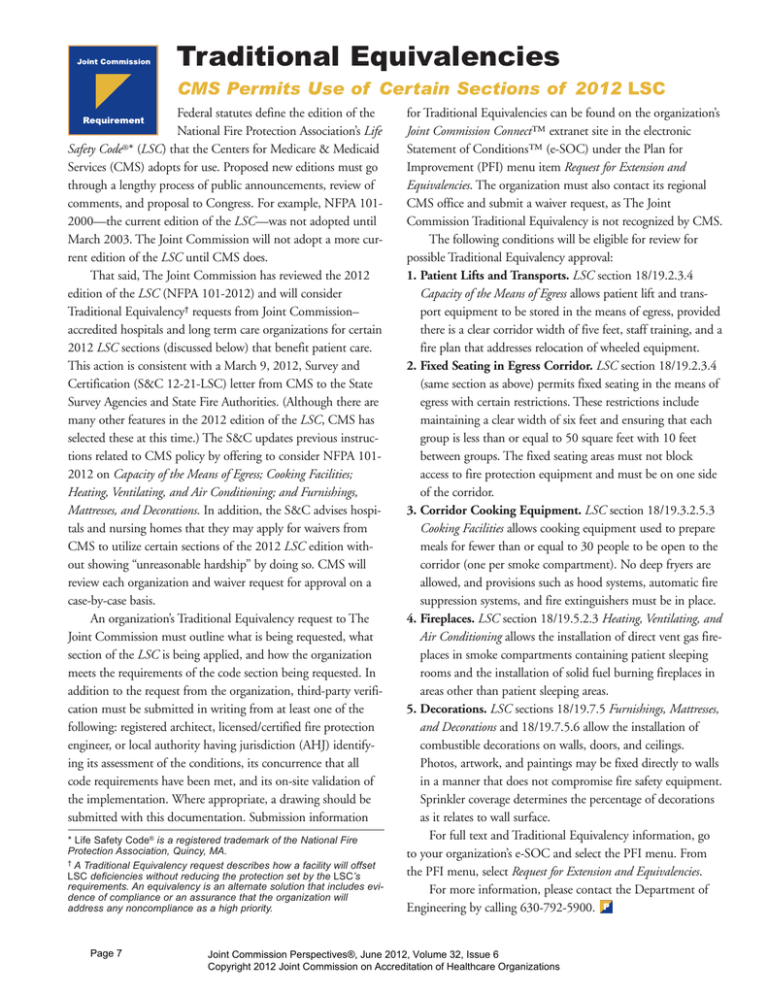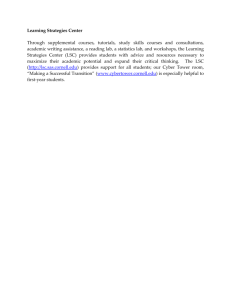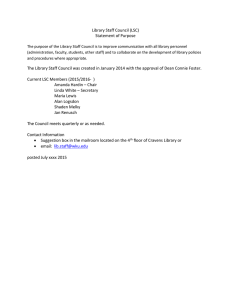Traditional Equivalencies
advertisement

Traditional Equivalencies CMS Permits Use of Certain Sections of 2012 LSC Federal statutes define the edition of the National Fire Protection Association’s Life ® Safety Code * (LSC) that the Centers for Medicare & Medicaid Services (CMS) adopts for use. Proposed new editions must go through a lengthy process of public announcements, review of comments, and proposal to Congress. For example, NFPA 1012000—the current edition of the LSC—was not adopted until March 2003. The Joint Commission will not adopt a more current edition of the LSC until CMS does. That said, The Joint Commission has reviewed the 2012 edition of the LSC (NFPA 101-2012) and will consider Traditional Equivalency† requests from Joint Commission– accredited hospitals and long term care organizations for certain 2012 LSC sections (discussed below) that benefit patient care. This action is consistent with a March 9, 2012, Survey and Certification (S&C 12-21-LSC) letter from CMS to the State Survey Agencies and State Fire Authorities. (Although there are many other features in the 2012 edition of the LSC, CMS has selected these at this time.) The S&C updates previous instructions related to CMS policy by offering to consider NFPA 1012012 on Capacity of the Means of Egress; Cooking Facilities; Heating, Ventilating, and Air Conditioning; and Furnishings, Mattresses, and Decorations. In addition, the S&C advises hospitals and nursing homes that they may apply for waivers from CMS to utilize certain sections of the 2012 LSC edition without showing “unreasonable hardship” by doing so. CMS will review each organization and waiver request for approval on a case-by-case basis. An organization’s Traditional Equivalency request to The Joint Commission must outline what is being requested, what section of the LSC is being applied, and how the organization meets the requirements of the code section being requested. In addition to the request from the organization, third-party verification must be submitted in writing from at least one of the following: registered architect, licensed/certified fire protection engineer, or local authority having jurisdiction (AHJ) identifying its assessment of the conditions, its concurrence that all code requirements have been met, and its on-site validation of the implementation. Where appropriate, a drawing should be submitted with this documentation. Submission information * Life Safety Code® is a registered trademark of the National Fire Protection Association, Quincy, MA. † A Traditional Equivalency request describes how a facility will offset LSC deficiencies without reducing the protection set by the LSC’s requirements. An equivalency is an alternate solution that includes evidence of compliance or an assurance that the organization will address any noncompliance as a high priority. Page 7 for Traditional Equivalencies can be found on the organization’s Joint Commission Connect™ extranet site in the electronic Statement of Conditions™ (e-SOC) under the Plan for Improvement (PFI) menu item Request for Extension and Equivalencies. The organization must also contact its regional CMS office and submit a waiver request, as The Joint Commission Traditional Equivalency is not recognized by CMS. The following conditions will be eligible for review for possible Traditional Equivalency approval: 1. Patient Lifts and Transports. LSC section 18/19.2.3.4 Capacity of the Means of Egress allows patient lift and transport equipment to be stored in the means of egress, provided there is a clear corridor width of five feet, staff training, and a fire plan that addresses relocation of wheeled equipment. 2. Fixed Seating in Egress Corridor. LSC section 18/19.2.3.4 (same section as above) permits fixed seating in the means of egress with certain restrictions. These restrictions include maintaining a clear width of six feet and ensuring that each group is less than or equal to 50 square feet with 10 feet between groups. The fixed seating areas must not block access to fire protection equipment and must be on one side of the corridor. 3. Corridor Cooking Equipment. LSC section 18/19.3.2.5.3 Cooking Facilities allows cooking equipment used to prepare meals for fewer than or equal to 30 people to be open to the corridor (one per smoke compartment). No deep fryers are allowed, and provisions such as hood systems, automatic fire suppression systems, and fire extinguishers must be in place. 4. Fireplaces. LSC section 18/19.5.2.3 Heating, Ventilating, and Air Conditioning allows the installation of direct vent gas fireplaces in smoke compartments containing patient sleeping rooms and the installation of solid fuel burning fireplaces in areas other than patient sleeping areas. 5. Decorations. LSC sections 18/19.7.5 Furnishings, Mattresses, and Decorations and 18/19.7.5.6 allow the installation of combustible decorations on walls, doors, and ceilings. Photos, artwork, and paintings may be fixed directly to walls in a manner that does not compromise fire safety equipment. Sprinkler coverage determines the percentage of decorations as it relates to wall surface. For full text and Traditional Equivalency information, go to your organization’s e-SOC and select the PFI menu. From the PFI menu, select Request for Extension and Equivalencies. For more information, please contact the Department of Engineering by calling 630-792-5900. P Joint Commission Perspectives®, June 2012, Volume 32, Issue 6 Copyright 2012 Joint Commission on Accreditation of Healthcare Organizations

